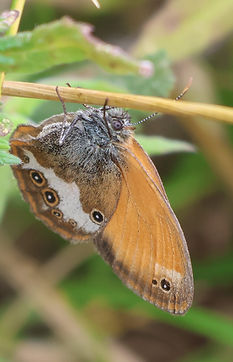

Photo: A. Chaudron, AIFM
#WeeklyIntegradivSp

V. Kati
𝘊𝘰𝘦𝘯𝘰𝘯𝘺𝘮𝘱𝘩𝘢 𝘢𝘳𝘤𝘢𝘯𝘪𝘢
It is found in forest edges, clearings, and grassy slopes throughout much of Europe.
The species name “arcania” is derived from the Latin arcanus, meaning secret or mysterious, maybe because of its flight and shy nature.

Daniel Pavon
𝘗𝘳𝘶𝘯𝘶𝘴 𝘣𝘳𝘪𝘨𝘢𝘯𝘵𝘪𝘯𝘢
Although it is only found in the South Western Alps, its conservation status and ecology are not well known. To fill this gap, it is one of the species for which INTEGRADIV collected new samples, including some cool chemical analysis!

Adrian Colino Berea
𝘊𝘢𝘱𝘳𝘦𝘰𝘭𝘶𝘴 𝘤𝘢𝘱𝘳𝘦𝘰𝘭𝘶𝘴
Found across much of Europe, this species is well-adapted to diverse habitats, but because it lives in small home ranges and depends on vegetation for cover and forage, habitat alteration can affect them strongly

Adrian Colino Berea
𝘚𝘤𝘪𝘶𝘳𝘶𝘴 𝘷𝘶𝘭𝘨𝘢𝘳𝘪𝘴
Found across Europe (including parts of Mediterranean forests) and northern Asia, the red squirrel (also called the Eurasian red squirrel) is a classic forest dweller. In certain regions, red squirrels are threatened by the introduction of the eastern grey squirrel (𝘚𝘤𝘪𝘶𝘳𝘶𝘴 𝘤𝘢𝘳𝘰𝘭𝘪𝘯𝘦𝘯𝘴𝘪𝘴), which competes for food and may carry diseases (such as squirrelpox) that the native red squirrels are vulnerable to.

Frédéric Médail
𝘊𝘺𝘵𝘪𝘴𝘶𝘴 𝘢𝘦𝘰𝘭𝘪𝘤𝘶𝘴
This species is one of the few legumes growing as a tree in the Mediterranean. The only place in the world where it is found is the Stromboli volcano where it forms forests in the middle of the sea!!

Daniel Pavon
Melanargia larissa
It inhabits dry grasslands, rocky slopes & open woods, is localized & sensitive to habitat loss 🎯 “Larissa” may refer to a Greek nymph: fitting for a butterfly gracing sunlit hillsides with elegance

Daniel Pavon
𝘋𝘳𝘺𝘰𝘤𝘰𝘱𝘶𝘴 𝘮𝘢𝘳𝘵𝘪𝘶𝘴
One of the largest woodpecker species in the world, the black woodpecker. These birds love to make their presence felt, as they are very noisy, and their drumming sound can be heard from up to 4 kilometers away!

Daniel Pavon
𝘘𝘶𝘦𝘳𝘤𝘶𝘴 𝘱𝘶𝘣𝘦𝘴𝘤𝘦𝘯𝘴
The downy oak has the particularity to emit huge amounts of isoprene, a volatile organic compound influencing the chemical compoistion of the atmosphere, in turn impacting air quality and regional climate!

Daniel Collado
Callophrys rubi
The Green Hairstreak is a small butterfly found across Europe and Asia, easily recognized by its vivid green underwings. It lives in sunny scrublands, heathlands, and woodland edges.
Its green color is not due to pigment but to tiny wing structures that scatter light - a rare example of structural green in nature!


Daniel Collado
𝘓𝘢𝘤𝘦𝘳𝘵𝘢 𝘣𝘪𝘭𝘪𝘯𝘦𝘢𝘵𝘢
Found inside our study area in Spain, France, Italy, Croatia & Slovenia!
Males bite & guard females after mating — nature’s way of boosting their paternity odds. striking species with a striking behavior.

Manuel Cartereau
𝘕𝘦𝘳𝘪𝘶𝘮 𝘰𝘭𝘦𝘢𝘯𝘥𝘦𝘳
You probably already know the oleander from your backyard as it is very commonly cultivated as an ornamental species all around the world. But did you know that the Mediterranean Basin hosts wild and indigenous populations of this species?

V. Kati
𝘈𝘳𝘨𝘺𝘯𝘯𝘪𝘴 𝘱𝘢𝘱𝘩𝘪𝘢
This large, graceful butterfly can be found across Europe, especially in sunny woodlands and forest edges. Its name, 𝘱𝘢𝘱𝘩𝘪𝘢, links it to Paphos (Cyprus), birthplace of Aphrodite — a fitting namesake for such a beautiful species.

Juan A. Hernández-Agüero
𝘊𝘦𝘳𝘷𝘶𝘴 𝘦𝘭𝘢𝘱𝘩𝘶𝘴 𝘩𝘪𝘴𝘱𝘢𝘯𝘪𝘤𝘶𝘴
This subspecies is endemic to the Iberian Peninsula, and was nearly extirpated from Portugal — but thanks to conservation efforts like the reintroductions in Serra da Lousã, it’s made a remarkable comeback.

Santiago Soliveres
Leiopicus medius
Medium sized woodpecker that prefers deciduous forests, mainly oak & beech trees 🌳
The protection of oak & beech forests is thus crucial for the survival of this species, so let’s all try our best to help these birds thrive!

Santiago Soliveres
𝘡𝘢𝘮𝘦𝘯𝘪𝘴 𝘴𝘤𝘢𝘭𝘢𝘳𝘪𝘴
This non-venomous snake is common in the Iberian Peninsula and southern France. Its "ladder" name comes from its striking H-shaped dorsal marks.
Often feared, but totally harmless, it is a vital pest controller and is key to ecosystem health.

N. Boukas
𝘈𝘨𝘭𝘢𝘪𝘴 𝘪𝘰
Famous for its large eye-like wing spots that deter predators by mimicking a peacock’s plumage, is found across Europe and inhabits meadows and woodland edges. Adults are among the first butterflies seen in spring.

N. Boukas
𝘗𝘦𝘳𝘯𝘪𝘴 𝘢𝘱𝘪𝘷𝘰𝘳𝘶𝘴
On this #WeeklyIntegradivSp, to celebrate World Migratory Bird day was last satuday, we have the chance to meet a migratory raptor species called 𝘗𝘦𝘳𝘯𝘪𝘴 𝘢𝘱𝘪𝘷𝘰𝘳𝘶𝘴.
Fun fact: Although “𝘢𝘱𝘪𝘷𝘰𝘳𝘶𝘴” means bee 🐝 – eating in Latin, these birds prefer (but don’t depend solely on) wasp’s larvae and nests!

Manuel Cartereau
𝘊𝘩𝘢𝘮𝘢𝘦𝘳𝘰𝘱𝘴 𝘩𝘶𝘮𝘪𝘭𝘪𝘴!
The mediterranean dwarf palm 🌴 is one of the only two indigeneous palm species in Europe.
Endemic to the Western #Mediterranean Basin where in some places it is a pivotal component of coastal woodlands.
Photo of Mallorca.

Juan Antonio Hernández Agüero
𝘊𝘢𝘱𝘳𝘢 𝘱𝘺𝘳𝘦𝘯𝘢𝘪𝘤𝘢
Endemic to the Iberian Peninsula, this mountain goat survived glaciations in a climatic refugia. Now, rising temps push it northward and upslope—often to peaks in summer. A species shaped by past climates, and challenged by future ones. ⛰️🌍

Daniel Collado
𝘗𝘴𝘢𝘮𝘮𝘰𝘥𝘳𝘰𝘮𝘶𝘴 𝘢𝘭𝘨𝘪𝘳𝘶𝘴
𝘗𝘴𝘢𝘮𝘮𝘰𝘥𝘳𝘰𝘮𝘶𝘴 𝘢𝘭𝘨𝘪𝘳𝘶𝘴🦎Found in the Iberian Peninsula & North Africa. Its genus is phylogenetically unique, with its closest relative 𝘎𝘢𝘭𝘭𝘰𝘵𝘪𝘢, endemic to the Canary Islands. Preserving species like this helps conserve 15+ million years of evolutionionary history.🌿

Daniel Collado
𝘈𝘦𝘨𝘪𝘵𝘩𝘢𝘭𝘰𝘴 𝘤𝘢𝘶𝘥𝘢𝘵𝘶𝘴
The long-tailed tit! 🐦 With a tail nearly as long as its body (7–9 cm), this fluffball is easy to recognize. It’s a sociable, insectivorous bird found across the Palearctic region. Its genus name, Aegithalos, was already used by Aristotle!

Saul Bernat Ponce
𝘗𝘢𝘱𝘪𝘭𝘪𝘰 𝘮𝘢𝘤𝘩𝘢𝘰𝘯
This butterfly is found throughout the Palearctic region, appearing in almost all of our study area! Its caterpillar is fascinating: when threatened, it activates an organ called the osmeterium, which emits a foul odour to scare off predators.

Frédéric Médail
𝘊𝘦𝘳𝘢𝘵𝘰𝘯𝘪𝘢 𝘴𝘪𝘭𝘪𝘲𝘶𝘢
Let's meet 𝘊𝘦𝘳𝘢𝘵𝘰𝘯𝘪𝘢 𝘴𝘪𝘭𝘪𝘲𝘶𝘢! The carob tree has been dispersed by human societies across the #Mediterranean Basin for milienias. Indeed, it is widely cultivated for its edible pods which can be used as a substitute for cocoa powder!


